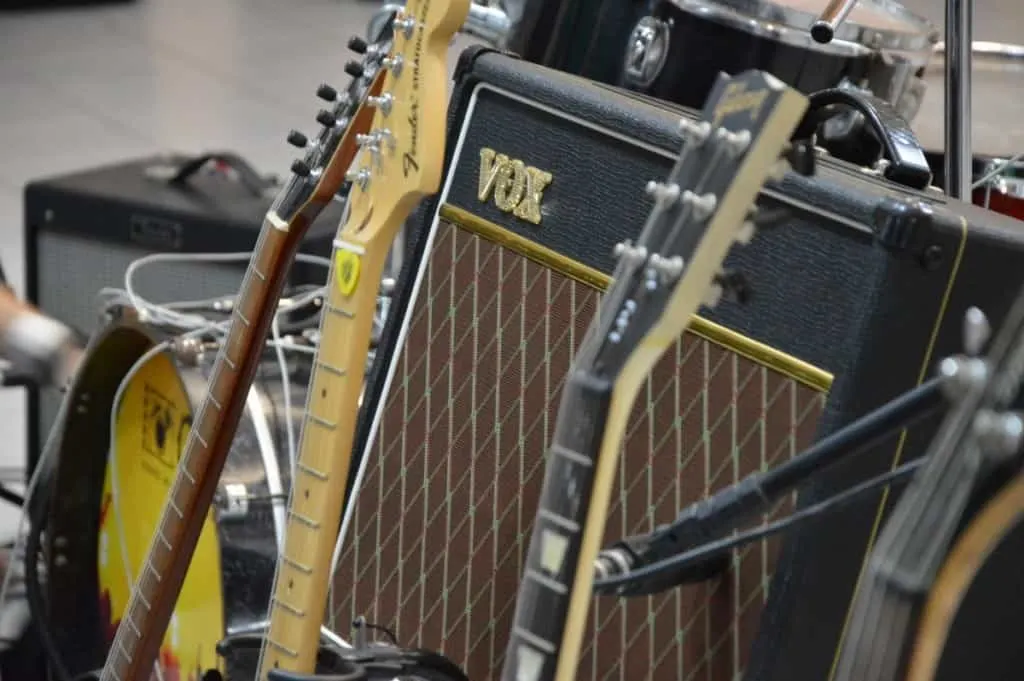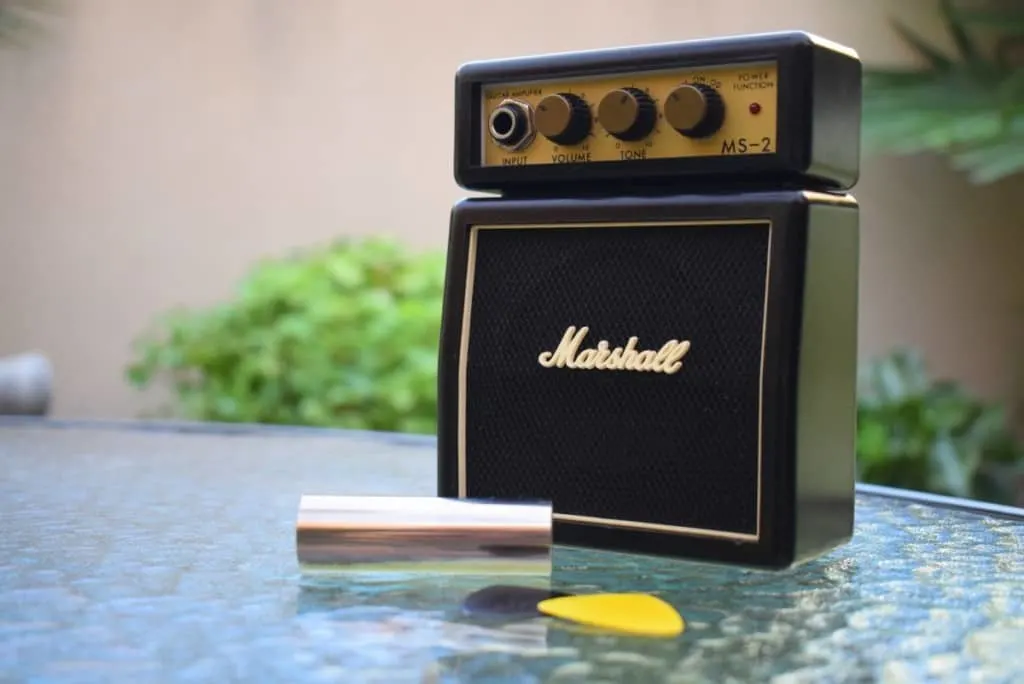From guitar to bass to keyboard and vocals, all musicians need some form of amplification. For this purpose, you can select an amp head + cabinet (stack or half stack) or you can pick a combo amp for your rig.
So, what is a combo amplifier?
A combo amp is an all-in-one amplifier that combines the amplifier and the speaker. As a general rule, these two components are integrated and cannot be isolated for individual use or upgrades. Most big-name brands offer several combo amps for guitar, bass, and other instruments.
Combo amps hit the scene in the 1930s and 40s but it took a while for the industry to accept them. Today, they are found in every continent and have become an integral part of our set-up.
As technology develops, we witness new and efficient innovations like digital amp modeling that are turning out to be a hit with guitar and bass players.
In this article, we’ll look at combo amps alongside some basic comparisons to other types and several recommendations for beginner-to-intermediate musicians.
I have written an article that discusses the differences between guitar and bass amps. You can read it here.

The Most Common Types Of Guitar Amps:
Musicians, especially guitarists, tend to casually use the word ‘amp’ or ‘amplification’ in a casual way that can be deceptive and ambiguous for beginners. In the music world, everything “can” be called an amp. It could be a combo, a stack, or something else altogether.
Before we proceed, let’s look at the different types of amplifiers on the market:
Combo Amp:
Basic Combo Amp: A basic combo amp is a speaker and amp in the same box. The combo amp market offers immense variety in terms of color, shape, size, power, and price range. From a 10W tiny terror to a 100W gigging workhorse, you can find options that offer a lot of choice in terms of power, tone, and control.
Combo Amp with Amp Modeling: Modeling amps combine the latest tech with the traditional combo amp to give you more flexibility in tone sculpting. They have a range of “digital” amps and cabs (using amp modeling technology) that allow you to access multiple tones from a single unit.
Let’s take the example of a Marshall Code 25 Combo Amp. It is a 25W solid-state amp that has a 10″ speaker. Code 25 has 4 power-amps, 14 preamps, and 8 speaker cabs that can be mixed and matched to get a plethora of tones ranging from vintage to modern. The amp also has 100 presets, USB + Bluetooth Connectivity, and 24 fx options.
Take a look at this demo of the Marshall Code 25 Amp.
Take look at this amp here on Amazon.
Amp + Cabinet:
- Half Stack: A half stack refers to a head + speaker cabinet. It probably gets its name because the head is stacked on top of the cabinet. In a half stack, the cabinet can have up to four speakers. They are heavy and tall, usually 75” in height.
- Full Stack: This blow-your-wig-off stack is still the ultimate dream of many rock and metal guitarists because it is loud and great for distortion. A full-stack is the same as a half-stack with an additional speaker cabinet. Angus Young of AC/DC is known to perform live concerts using a Marshall stack (with a wall of speakers).
Is A Combo Amp Any Good?
There are many advantages of owning a combo amp regardless of what instrument you play.
Combo amps are affordable, portable, and available in various avatars. They are a good choice for rehearsals, jamming, practice, and performances at small-to-mid-sized venues.
Many combo amplifiers are ‘voiced’ in a way that gives them a unique sonic character – for which they become famous and are preferred over others.
In general, they are easy to tote around as compared to the stack (amp + cabinet) because you only have to carry one unit instead of two. Contrary to popular belief, several pro-musicians use combo amps for live performances and recording in the studio.
However, individual needs and choices vary. Tone is a highly subjective topic, which makes it hard to say what works best without knowing the context. Musicians must weigh the pros and cons of each type before deciding what works best.
I have written an article that discusses the differences between guitar and keyboard amps. You can read it here.
The Difference Between A Combo Amp And Amp Head + Speaker Cabinet:
The amp head, by itself, can only bring the signal from your guitar, bass, or any other source to line-level. It does not contain any means to make that signal audible. This is where the speaker cabinet comes into play.
The Amp head/Cab (or stack) are two separate units that can be bought individually.
Since they are not integrated, you can upgrade one or both of them as and when needed. The amp head amplifies the guitar and the cabinet has speakers (or a single speaker) to play the sound.
You will notice various amp heads and cabinets are ‘paired’ or ‘matched’. This means that the manufacturer has created the head and cabinet to complement each other. However, this doesn’t mean that you are obligated to use the pair.
It is perfectly fine to mix and match amp heads with cabinets from different product lines or even other brands. However, if you choose to pair them with their ‘matched’ pair, they offer a ‘tried and tested’ sound, which can make it a straightforward decision.
Is A Combo Amp Better Than Amp Head + Cabinet?
Each type has its pros and cons and the decision varies even among professional musicians and studio owners. Based on your preference, you can review the options based on genre, style, and tone.
Sonically, a head/cab would be considered more capable of power and tone. Yet, there is no clear answer to which one is better. The two options vastly vary in price, space, weight, and tone. Each type has its advantages and disadvantages in certain scenarios.
A combo amp can cost you less than $100. It provides sufficient volume for individual practice and basic jams/rehearsals. It’s affordable, lightweight, and portable. For this reason, most students and beginners prefer combo amps.
However, half-stacks or stacks are far superior when it comes to volume or projection. A 100W Marshall head with a matched 4×12 cabinet can be persuasive if you want your neighbors to move.
Jokes apart, head & cab rigs are more versatile because they are not fixed to one another. This allows professional musicians to own several heads and cabinets, which they can mix and match at will based on the genre and musical context.
Moreover, professional musicians have the resources to afford and transport their equipment. This may be one of the factors why they lean towards the more powerful and tonally capable amp head + cabinet choices, despite certain inconveniences involved.
You will find all types of permutations and combinations in each of the aforementioned options. You may get a tube combo amp like the Blackstar HT20R MKII (20W) or a solid-state combo amp such as the Fender Champion 20W. Similarly, you can select from a wide range of tube or solid-state amp heads and match them with an equally varied catalog of speaker cabinets.

Related Questions: Guitar Combo Amp FAQ
What is a combo tube amp?
Combo amps are available as solid-state amps or tube amps.
Tube combo amps use vacuum tubes (called valves) instead of the electronic transistors used in solid-state amps. Since both types use varying means to derive amplification, there is a distinct difference in the sound.
Tube amps are known to have a “creamy’ overdrive/distorted tone on account of the signal break up.
What are boutique combo amps?
Boutique “amps” refer to certain non-mainstream brands that meticulously craft their amps with great attention to components and tone.
They gain a fan following on account of their peculiar looks, tone color, or attention to detail. However, boutique amps are generally very expensive. They are preferred by audiophiles, connoisseurs, and professional musicians who know what they are looking for.
Which is the best combo amp for beginners?
- Orange Crush 20RT Power Amp
- Blackstar Fly 3 Mini Amplifier
- Marshall Guitar Combo Amp (M-MG10G-U)
- Fender Champion 20W Combo Amp
- Fender Mustang LT25 25W Combo Amp
Which is the best low-budget amp head (under $300)?
- Orange Micro Terror 20W Amp Head
- Fender Super Champ X2 15W Amp Head
- Orange Micro Dark 20W Tube Hybrid Amp Head
- Hotone Mojo Diamond 5W Guitar Amp Head
- BUGERA T5 5-Watt Amp Head with Infinium Tube
Final Thoughts:
For every beginner, selecting the ‘best’ amp will invariably become a tardy pit stop where you sit and waffle over all the options in the market.
From a 10W tiny terror to a rattle-and-roll mega 100-watt solid-state amp, combo amps are seen as an easy-to-use, versatile, and suitable option for guitar players at every level.
Amplification is a vast subject, but I hope this article has provided a birdseye view on the subject. This article has only touched upon the basics in the context of combo amps. We’ve presented several other articles on this topic that you may find helpful.
